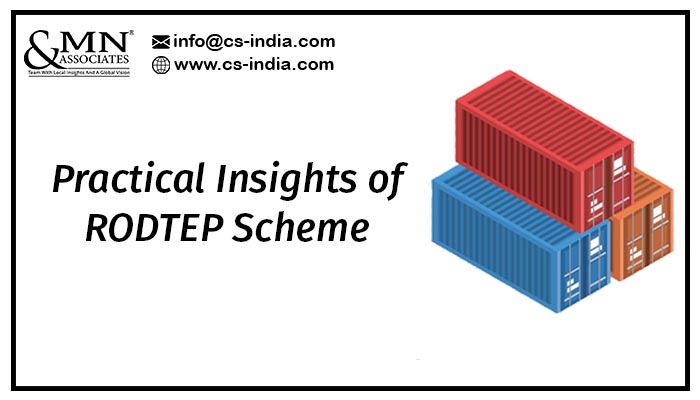
Practical Insights of RODTEP Scheme
The rate of growth of the economy is largely affected by the exports made in different sectors. The Remission of Duty or Taxes Scheme has been launched in 2019 which replaced the Merchandise Exports from India Scheme (MEIS) and Rebate of state & central Taxes & Levies (RoSCTL) which was launched in the year 2019 itself due to objection by World Trade Organization.
Under MEIS, a fixed percentage of the export value of goods is remitted whereas the RoDTEP scheme will provide a refund of all the taxes levied rather than exemption or rebate, for which detailed notification is pending from the department.
Features of RODTEP Scheme:
Some of the important features of the scheme are as follows:
- The scheme is applicable to the manufacturing sector as well as the service sector.
- The scheme is in effect from 1st January 2020.
- The existing sectoral norms committee structure will also function as sectoral RoDTEP
- RODTEP Scheme is a WTO compliant scheme that enables the exporters to make claim or custom duties or taxes paid on the basis of testing and certification based on international standards and certification will be made to the exporters within the country.
- It is a fully automated scheme, which implies that the taxes or duty paid will be refunded online only, which enables transparency and functionality by the department in a time-bound manner for effective applicability.
- The RODTEP scheme would reimburse the central and state indirect taxes which streamlined the payments and refunds claim, thus a simplified process.
- This further reduced the costs associated with the goods manufactured/produced and exported by small and medium enterprises (SME/ MSMEs).
The duties or taxes paid by the entity/individual as exporter/importer is categorized and remission will be by the concerned authority is highlighted as under:
- Custom duties:-
The entity/individual can claim the customs duty paid in the prescribed format to the Assistant Commissioner of Customs having jurisdiction over the custom port, airport, land customs or customs warehouse where customs or interest levied was paid.
- Integrated Goods and Services Tax (IGST) Credit:-
As per the new scheme, the automated GST tax refund can be done by submitting the documents as listed below on the Common Portal in the prescribed format.
The amount paid as duty can be claimed in Form GST RFD – 01A, by the registered taxpayer. The amount of tax refund should necessarily be above Rs. 1000.
- Other Central/state taxes levied:-
For such other taxes on the central or state level will be refunded on the basis of filing in Form R1, R2, and R3, which need be filled for each export product by an exporting unit or manufacturing unit as the case may be. All three performa should be filled for claiming remission on taxes paid.
Such central/state taxes are not refunded or remitted by any other authority concerned. The information should be disclosed by the manufacturer or manufacturer exporter unit and the authorized signatory.
The limits also raised for credit facilities to such exporters to Rs. 40 crore and the turnover criteria as an eligibility criterion has been removed.
Information required:
- The details of the exporting unit.
- Data relating to Domestic Tariff Area (DTA) and/or Special Economic Zone (SEZ) unit / Export Oriented Unit (EOU)/ FTWZ/ Warehouse under Section 65 of Customs Act as the case may be need be filed separately for each such unit.
- A list of indictive taxes.
- Details of incidence of central/state taxes suffered on account of different inputs e.g., petroleum products. The details of such taxes where other taxes are refunded should not be disclosed.
Reimbursement Procedure:
Classification of all taxes which can be reimbursed or can not be reimbursed shall be filed in the applications. All of the data disclosed by the persons need to be preserved for the purpose of verification of data/processes.
- Such applications to be filed with the Trade & Industry.
- Generation of Application ID.
- Submission of information or clarifications by the exporter to the department as required.
- Reimbursement of the claimed amount in application or percentage of the claimed amount.
Therefore, upon contradiction of schemes on the international level, the reforms have been brought in the public interest simplifies and made transparent the remission process of the taxes paid.
Need assistance in business registrations?
Reach us at info@cs-india.com
Also Read: Dormant Companies under Companies Act, 2013
